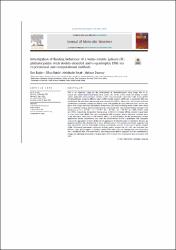| dc.contributor.author | Bağda, Esra | |
| dc.contributor.author | Bağda, Efkan | |
| dc.contributor.author | Koçak, Abdulkadir | |
| dc.contributor.author | Durmuş, Mahmut | |
| dc.date.accessioned | 2022-05-16T09:05:47Z | |
| dc.date.available | 2022-05-16T09:05:47Z | |
| dc.date.issued | 2021/9/15 | tr |
| dc.identifier.citation | Bağda, E., Bağda, E., Kocak, A., & Durmuş, M. (2021). Investigation of Binding behaviour of a water-soluble gallium (III) phthalocyanine with double-stranded and G-quadruplex DNA via experimental and computational methods. Journal of Molecular Structure, 1240, 130536. | tr |
| dc.identifier.uri | https://hdl.handle.net/20.500.12418/13128 | |
| dc.description.abstract | DNA is an important target for the development of chemotherapeutic drug design due to increased and uncontrolled cell proliferation of cancer cells. In the present study, the affinity of water-soluble gallium(III) phthalocyanine chloride (GaPc) non-peripherally substituted with 2-mercapto-N-methylpyridinium groups to different types of DNA (double-stranded ctDNA and G-quadruplex DNA) was investigated. The interaction mechanisms were evaluated by UV-Vis, fluorescence and circular dichroism spectroscopic techniques, competitive dialysis assay, and capillary gel electrophoresis (CGE) system integrated with a high sensitivity LED-induced fluorescence (LIF) detector. Binding mode studies were carried out by molecular docking and molecular dynamic simulations. The experimental binding constants were determined as 1.9 × 106 M−1, 1.1 × 106 M−1, 8.5 × 105 M−1, 2.9 × 104 M−1 for c-MYC, AS1411, Tel21, and ctDNA, respectively. Competitive binding assay confirmed the higher affinity towards G-quadruplex structure rather than ctDNA. The GaPc-G-quadruplex DNA conjugates showed higher Kb constants and a strong absorption band closer to NIR window which is a desired feature for the photodynamic therapy applications. Besides, experimental data show that the formation of GaPc-G-quadruplex DNA conjugates reduced the aggregation of GaPc. Reduction of aggregation of phthalocyanine is important. Because aggregation decreases the photoactivity of most photosensitizers. The experimental results suggested that both intercalative and non‑intercalative binding contributions occurred in the case of double-stranded ctDNA. Confirming experiments, molecular docking studies showed that the GaPc can bind from two different major groove regions in double-stranded DNA while only one binding mode was observed in the G-quadruplex DNA. Both experimental and computational studies suggested that the conformational change and unfolding mechanism in G-quadruplex DNA structure were determined upon interaction with GaPc. | tr |
| dc.rights | info:eu-repo/semantics/openAccess | tr |
| dc.subject | Gallium(III) PhthalocyanineWater-solubleG-Quadruplex DNACircular dichroism spectroscopyComputational study | tr |
| dc.title | Investigation of Binding behaviour of a water-soluble gallium (III) phthalocyanine with double-stranded and G-quadruplex DNA via experimental and computational methods | tr |
| dc.type | article | tr |
| dc.contributor.department | Eczacılık Fakültesi | tr |
| dc.relation.publicationcategory | Uluslararası Hakemli Dergide Makale - Kurum Öğretim Elemanı | tr |















